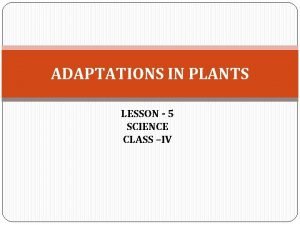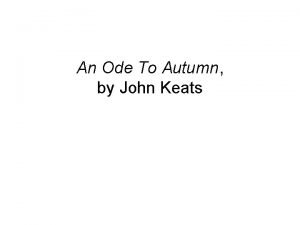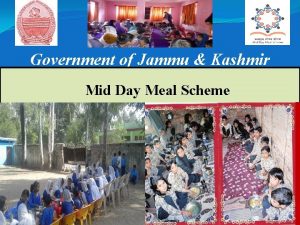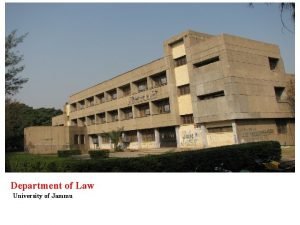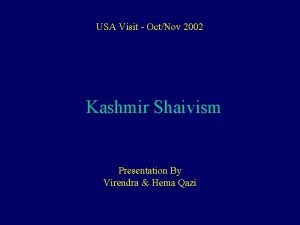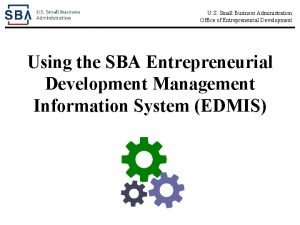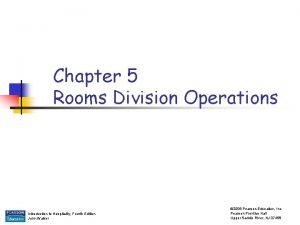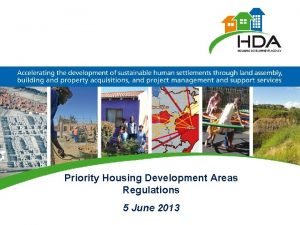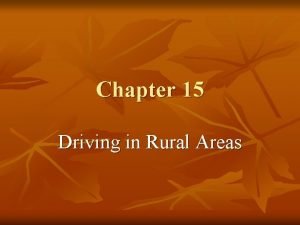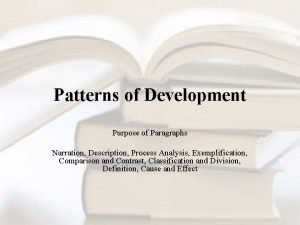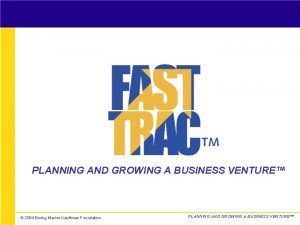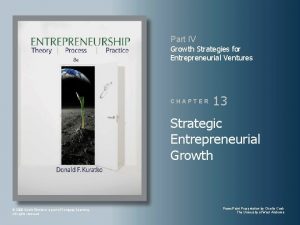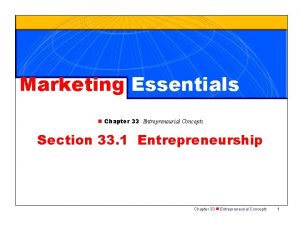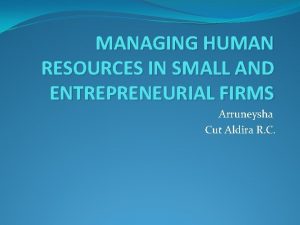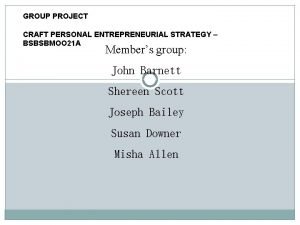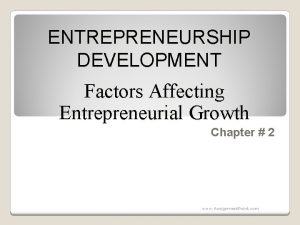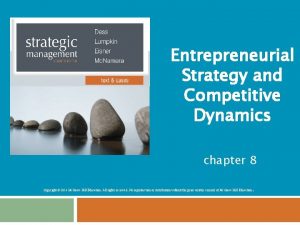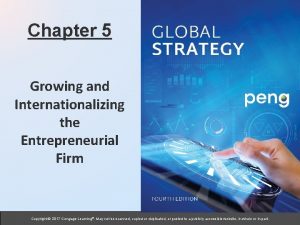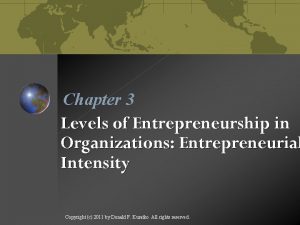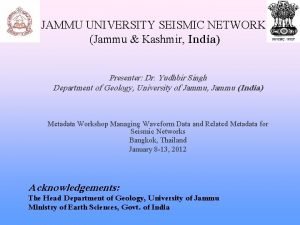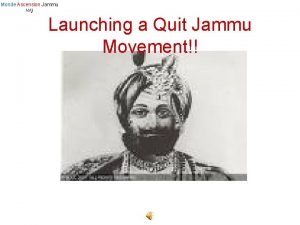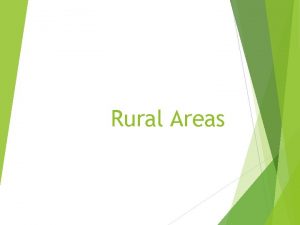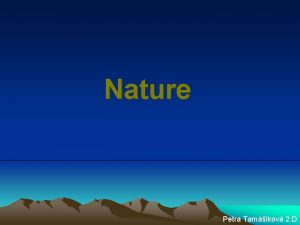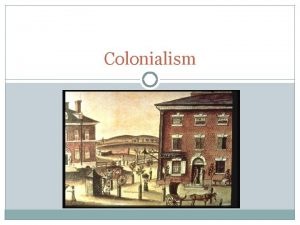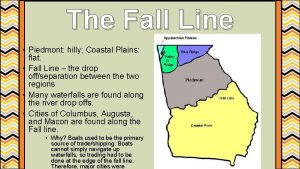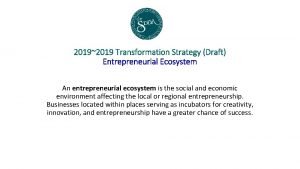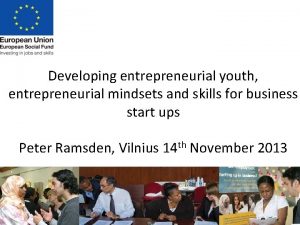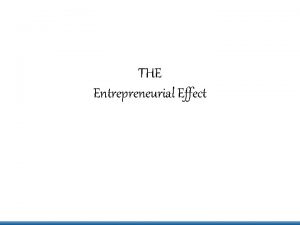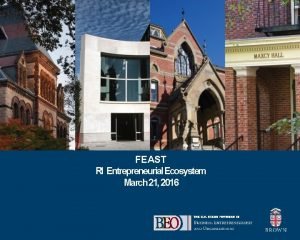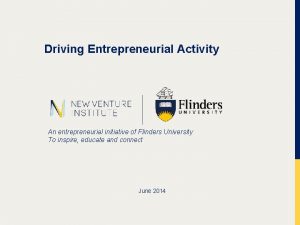ENTREPRENEURIAL DEVELOPMENT IN HILLY AREAS OF JAMMU DIVISION




































- Slides: 36

ENTREPRENEURIAL DEVELOPMENT IN HILLY AREAS OF JAMMU DIVISION- A Case Study of Doda District Dr. Y. P. Sharma Assistant Professor & Head, Department of Commerce, Govt. P. G. College, Rajouri, JAMMU

RESEARCH �Research- An inseparable part of human life. �Research is as old as the academic consciousness of human mind �Man’s earlier research interests have been recorded in the operation of the universe-to understand explore the outer world �Socrates, Plato & Aristotle, the Greeksgave a direction to philosophy of thought and developed the concepts of the relationship of man to society

Cont. �Historians put Aristotle ahead of his tutor in so far as the analysis is concerned- relentless quest for facts, based assertions on field observations and thus added dimension of empiricism to research �Nicholas Copernicus changed the world by doing extensive work on the phenomenon of universe and brought about considerable impact on social thought and human behaviour �In the age of Galileo, Newton and other contemporaries, scientific enquiry strengthened and intellectual process developed more on the lines which may rightly be called research

Cont. �Karl Marx goes down in history not only as a great economist but a man who has created socio- philosophical impact on the latest human history of the world �Darwin’s significant contribution on theory of Evolution in the middle of 19 th century brought about an intellectual revolution in the world

Entrepreneurship �“Entrepreneur”- derived from French verb ‘enterprendre’ which means to undertake �Joseph A. Schupeter- Entrepreneur is one who introduces something new in the economy �Peter F. Drucker- Entrepreneurs as “innovators”

Emergence of Entrepreneur �Industrial Revolution the main cause Entrepreneurship in Developing Countries �Developing countries are tied by a chain whose main links are in general poverty, ignorance, low productivity and various static and stagnating sets of conditions

Entrepreneurship Development in India � Industrial Policy Resolution, 1948 � Small Industry Development Organization (SIDO), 1954 � National Small Industries Corporation(NSIC) , 1955 � Intensive Campaign, 1960 � Small Industry Extension Training Institute (SIET), 1962 � Scheme for Educated Unemployed, 1972 � NIESBUD, 1983 � Management Development Institute (MDI) � Institutes for Entrepreneurship Development (IEDs)

Cont. �Science and Technology Entrepreneurship Parks (STEPs) �Centre for Entrepreneurship Development (CED) �The Xavier Institute of Social Service in Ranchi �National Alliance of Young Entrepreneurs (NAYE) �Entrepreneurial Motivation Training Centre

Entrepreneurial Development in Doda District �District Doda is located in the north and north east portion of Jammu province. The altitude of the district varies from 3000 ft to 15000 ft above the sea level. The land form is rugged mountainous terrain and lies surrounded by three major mountain ranges of north west Himalayas, namely, Dulidar, Peer Panchal and rest Himalayan ranges. There are numerous lofty ridges and peaks towering the tract. The tributaries of river Chenab have formed small plateaus which are suitable for cultivation �Doda district extends over an area of 11, 691 sq. kms. and has a population of 6. 90 lakhs which accounts to be 5. 26% of the total area and 6. 85% of the total population of the state




Objectives of Study �To identify material resources in terms of agricultural and non-agricultural and human resources which may be utilized for entrepreneurial development; �To prepare resource inventory of material and human resources; �To study status of entrepreneurship in Doda District; �To make an in-depth study of environmental setting in the district for entrepreneurship development; �To identify and study the status of infrastructural

Objectives of Study � To study the existence of institutional support system which could provide fillip to industrial growth in the district so that concrete suggestions could be made to establish the support system; � To study the status of human resource development and also to suggest a concrete plan for its development; � To study the existing mechanism for overcoming the problems faced by the entrepreneurs so as to suggest a concrete plan for its establishment; and � To study the strengths and weaknesses of the area in terms of human and material resources and other infrastructural and institutional support system

HYPOTHESES �Material and human resources have been properly exploited for entrepreneurship development in Doda district �The Government has made all possible efforts for entrepreneurship development in Doda district

Methodology �Direct investigation method based on field survey of 21 villages selected from all the seven blocks of the district covered under study; and �Reliance on published and unpublished data obtained from publications and reports and other academic work done by the scholars

Research Design � The Present study relates to Doda District of Jammu and Kashmir State. Doda is the most remote and far flung district in Jammu Division and is third largest in area in the State after Leh and Kargil District. This way, it fully represents the hilly areas of Jammu division. The district has seven tehsils. Out of these seven tehsils, seven blocks have been chosen for study purposes. The selected blocks are Banihal, Thathri Kishtwar, Ghatt (Doda), Ramban, Gandoh (Bhalessa) and Bhaderwah. Out of these blocks Bhaderwah, Ghatt (Doda) and Kishtwar are developed and the rest are comparatively under developed

Selection of Villages �The Selection of Villages for collection of data has been done on the basis of economic development of each village which was obtained from Patwaris and other revenue officials. In all twenty 21 villages: Three villages from each block were selected at random for study purposes Selection of Households �It was decided to draw a sample of minimum of 5 households or a maximum of 25 households or 25% of the total households whichever is less from each of the 21 villages in seven blocks to make the study fully representative

This way, information was collected from 315 households; 160 entrepreneurs and 21 Patwaris, Nambardars and chowkidars etc. In all it constitutes the total number about 500 respondents Collection of Data � In order to meet the requirement of study and fulfill the objects of research, the data from three different sources was obtained. They were (a) Revenue officials/Village leaders, etc (b) Entrepreneurs and (c) The head of households � (a) Revenue officials/villages Leaders etc Data regarding resources inventory of the villages has been collected from revenue officials (Tehsildars, Patwaris, etc, Village Headmen (Nambardars) and Chowkidars etc. Information regarding geographic location, land animal holdings, composition of labour force, etc was collected personally from the revenue record. Data Relating to income composition and other characteristic features was also collected �

(b) Entrepreneurs In the selected villages entrepreneurs engaged in different activities were contacted and information about activity undertaken, manpower employed, quality of product produced problems faced by them and general observations was collected (C) Households : Data from common households in the village under study was also collected. The information regarding demographic composition, assets holding, occupational structure, etc. was collected. The data relating to pattern of expenditure, plan for future occupation/activity etc was also collected and canvassed personally by the researcher. After collection of data, it was tabulated. The data so tabulated was shifted and used in the construction of tables which provided the basis for analysis

Secondary Data The secondary data have also been collected from various publications, reports and journals etc Chapter - II Resource Inventory Material Resources of J & K Land use Pattern Forests Minerals (lime-stone, gypsum, bauxites, sapphire and marble)

Coal � Live Stock � Horticulture � Sericulture � Fisheries � Infrastructure (Power & Roads) � Material Resources of Doda Land (Forests Constitute 53% of total land area of Doda) Forests (Commercial Forests constitute 35. 8% of total forest area with deodar, Kail & Fir varieties)

� Live Stock (12. 79% of the total live stock of the state) � Minerals (ranks as number one in the state ) � Gypsum (Ca. So 4 2 H 2 O) � Lime stone (Ca Co 3) � Sapphire (Clear transparent blue variety of corundum) � Graphite (Graphite rocks available, but not exploited due to heavy cost) � Galona, nicke ore, dolomite, marble, copper ore, sulphite, silicon, minerals, quartz and quartzite

� Horticulture (apple, walnut, pear, apricot, peach and grapes etc � Sericulture (Geo-climatic conditions ideal for mulberry cultivation and cocoon rearing) Infrastructure � (i) Power (Dul Hasti (Kishtwar ) & Baghliar (Ramban) with 390 MW and 450 MW respectively � (ii) Roads (Fair weather roads network- 792 kms area) Human Resources in Doda District � Cultivators � Agricultural Laborers � Workers in households industry � Other workers

Chapter-III Plan for Entrepreneurial development � Socio Economic profile of Doda District � Demographic Composition � Occupational Structure � Distribution of Earners and Dependents in District Doda � Block wise Distribution of Industrial and Commercial activities in the district � Milch Animals and Milk Production in the District

Premises for Entrepreneurship Development �Institutional Support System �Role of Development Banks (Special Capital and Seed Capital by IDBI and others) �Role of commercial banks �Institutional finance to Entrepreneurs (LIC, Exim Bank, SFCs etc) �Marketing institutions and Assistance (Trade Centres, State Trading Corporation (STC) etc

Plan for Entrepreneurial Activities in Doda Disctirct � I. Resources Base Industries � (A) Industries Based on Mineral Resources Mineral Pulverization- Gypsum (is the primary raw material for manufacture of surgical plaster, gypsum boards, chalk crayons etc Gypsum Board (Useful in partitioning and finishing of apartments and dwellings) Chalk crayons (Manufactured out of Gypsum and useful for writing on black boards Hollow Blocks (Useful in construction of Buildings) Granite slabs (could be used for construction of residential buildings and apartments particularly in kitchens and bathrooms. No unit at present engaged in extraction and polishing of this mineral 1 2 3 4 5

6 7 B 1 2 Slates (Used commonly as roofing material for houses and dwellings). Three units are reportedly engaged in extraction of roofing slates Stone crushers (Stone grit finds use in construction of public works, buildings, dams, canals etc) Industries Based on Forest Resources Pencil, Pencil slate, cedar wood oil (required raw material i. e, Deodar wood is available adequately) Chip Boards (Basic raw material is wood waste and chips recovered from whole sizing timber)

3 Activated Carbon ( is amorphous carbon finding applications in bleaching of organic colouring matter; absorbing vapours, gases and impurities. Needed raw material is wood, Saw dust, Paddy husk etc 4 Wooden Joinery (Used In construction of building and commercial establishments 5 Wooden Furniture (Demand from all segments of society is on increase) 6 Manufacture of Handlooms and accessories (Doda is major handloom weaving district of J & K) (C) Horticulture Based Industrial units Walnut Bleaching and Processing (J & K is single largest producer of walnut in India. Doda is walnut growing district) 2 Jams, Squashes and Pickles ( Apples, Apricot and citrus fruit is abundant in Doda District)

(D) Industries based on Agricultural Produce, Oil seeds and Processing of Food � 1 Oil Extraction � 2 Composite Mills (for grinding of wheat etc) (E) Industries Based on Domestic By-products 1 Leather Tanning (Per year available skins and hides are 1. 80 lakhs in the District) 2 Wool Carding and spinning (raw wool availability 10 thousands tonnes/annum) 3 Silk Reeling (Presently 20 thousand cocoon are reared in the disctict) 4 Herbal Medicines (Medicinal and aromatic herbs grow wild in the forests of District Doda) 5 Coal Briquettes (Used as fuel in Bukharis manufactured out of coke breeze and saw dust)

II Demand Based Industries 1 Confectionery (Presently 3 units available producing low level of Confectionery) 2 Spice Grinding (Presently 6 units working in the District) 3 Exercise Note books 4 Detergent Powder 5 Leather Shoe Manufacturing 6 Aluminium Utensils 7 Agricultural Implements 8 Hosiery knitting ( Readymade Garments (6 units are suggested)

III Service Base Industries � � � Hotel (Economy type) Restaurant Dry-cleaning (Centrifuge) Electric (Electronic Gadgets, Sale and Servicing) Printing Press Opticals Sale and Service Chapter- IV Input Need for Entrepreneurship Development I. 1 2 3 II. 1 2 3 Environmental Analysis Political Environment Economic Environment Socio-Cultural Environment Institutional Framework for Entrepreneurship Development Education and Training Input Training input by J & K Handicraft & Handloom Corporations Training Input by J & K Handicraft and Handloom corporations in Doda District

III Financial Input for Entrepreneurship Development J & K State Financial Corporation Ltd. J & K State Industrial Development corporation Commercial Banks SFC, SIDCO, etc IV. Marketing Inputs 1 J & K Handicrafts (Sales and Export) Corporation 2 J & K Handloom Corporation 3 J & K State Horticulture Produce Marketing and Processing Corporation 1 2 3 4 Chapter-V Problems (A) (ii) (iii) Basic and Fundamental Factors Socio-Psychological Politico-Economic Lack of Institutional Support System

Operational Factors (i) Finance (ii) Raw material (iii) Labour (iv) Technology (v) Marketing � Other Problems 1) Lack of Standardization 2) Poor Designing 3) Poor Quality 4) Lack of Precision 5) Poor Finishing 6) Lack of Service after sales 7) Scale of Production 8) Distribution Contacts 9) Lack of Knowledge of Marketing 10) Ignorance of Potential Markets 11) Unfamiliarity with export activities procedure and market 12) know-how

12 13 14 (a) (b) (c) Terrorism Inhospitable Terrorism Infrastructure Roads Power Communication System Conclusion and Suggestions Like Jammu & kashmir State Doda District is endowed with abundant natural resources. The district which extends over an area of 11, 691 sq kms. with a population of 6. 9 lakhs is rich with these natural resource. Maximum land area is covered by forests (219 thousand hectares) followed by net area sown (64 thousand hectares). This way forests and agriculture form centre nerve of district’s economy. Minerals are also in abundance in the area. Though not fully explored due to terrain and cost factor. District is rich in horticulture. Fruit and cocoon production also shows huge figures. District is also endowed with plenty of water resources which could be exploited for generation of power.

SUGGESTIONS The main parameters of suggested model � Status of Entrepreneurial Activity � Material and Human Resource Inventory � Environmental Analysis of the Area � SWOT Analysis of the Region � Pattern of Infrastructural Development � Development of Institutional Support System � Plan for Human Resource Development � Mechanism to overcome the problems experienced by the present or prospective Entrepreneurs
 Floating plants
Floating plants Hilly bourn
Hilly bourn Mid day meal jammu and kashmir
Mid day meal jammu and kashmir Department of law university of jammu
Department of law university of jammu Azad jammu and kashmir divisions
Azad jammu and kashmir divisions Conclusion of jammu and kashmir
Conclusion of jammu and kashmir Quotes on kashmir issue
Quotes on kashmir issue Sba gls account
Sba gls account Room division department
Room division department Long division and short division
Long division and short division Synthetic division pattern
Synthetic division pattern Key terms for division
Key terms for division Divide using synthetic division
Divide using synthetic division Phdas
Phdas Chapter 15 driving in rural areas
Chapter 15 driving in rural areas Example of definition in pattern of development
Example of definition in pattern of development Entrepreneurial skills pass
Entrepreneurial skills pass Kauffman center for entrepreneurial leadership
Kauffman center for entrepreneurial leadership Gbc entrepreneurship management
Gbc entrepreneurship management Entrepreneurial strategy matrix
Entrepreneurial strategy matrix Pathways to entrepreneurial ventures
Pathways to entrepreneurial ventures National level of entrepreneurial mindset
National level of entrepreneurial mindset Chapter 33 entrepreneurial concepts answers
Chapter 33 entrepreneurial concepts answers Managing human resources in small and entrepreneurial firms
Managing human resources in small and entrepreneurial firms How to craft a personal entrepreneurial strategy
How to craft a personal entrepreneurial strategy Factors affecting entrepreneurship growth
Factors affecting entrepreneurship growth Chapter 3 recognizing opportunity
Chapter 3 recognizing opportunity Entrepreneurial strategy and competitive dynamics
Entrepreneurial strategy and competitive dynamics Entrepreneurial feelings
Entrepreneurial feelings Personal entrepreneurial competencies meaning
Personal entrepreneurial competencies meaning Entrepreneurial motivation behaviour
Entrepreneurial motivation behaviour Opportunity pathways entrepreneurship
Opportunity pathways entrepreneurship Growing and internationalizing the entrepreneurial firm
Growing and internationalizing the entrepreneurial firm What are the 3 levels of entrepreneurship?
What are the 3 levels of entrepreneurship? Employee selection
Employee selection Strategic issues in entrepreneurial ventures
Strategic issues in entrepreneurial ventures The entrepreneurial mind lesson 1
The entrepreneurial mind lesson 1
